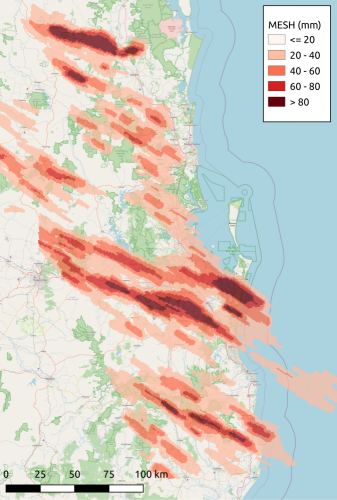Python Hail Retrievals Package (pyhail)#
Quick description#
This software provides Python functions for retrieving hail properties from weather radar data ingested via Py-ART. This includes the Maximum Estimated Size of Hail (MESH), Hail Accumulation (hAcc), Hail Differential Reflectivity (HDR) and the Hail Size Discrimination Algorithm (HSDA). MESH is implemented for both the Py-ART radar (ppi) and grid objects, and options are available for different fits of the SHI hail-size relationship. A notebook is provided to demonstrate how to call each retrieval.

Homepage#
Code Repository#
Software Documentation#
User group or forum page#
N/A
License model#
MIT License
Year of first release#
2022
Main programming laguage(s)#
Python
Supported platforms#
Linux
Type of software#
API/Library
Further details#
For help see README.md file. For license see the LICENSE file
Installation Make sure this directory is in your PYTHONPATH
Install Py-ART (ARM-DOE/pyart)
Install pyhail using pip
To use pyhail: from pyhail import hdr, mesh_grid, mesh_ppi, hsda, hacc
Then you have access to the main() functions for each retreival
Obtaining the turbulence field for a volume can be as simple as: import pyart from pyhail import mesh_ppi radar = pyart.io.read(‘YOUR_FILE_HERE’) meshppi_fields = mesh_ppi.main(radar, ‘REFLECTIVITY_FIELD_NAME’, levels=[‘0C_LEVEL’, ‘-20C_LEVEL]) radar.add_field(‘mesh’, meshppi_fields[‘mesh_mh2019_95’], replace_existing=True)
You will then have a field called ‘mh2019_95’ that can be plotted, analyzed, or saved to file like any other Py-ART radar field. The mesh field will use the default MESH formulation, mesh_mh2019_95, unless specified - see documentation for more details.
References#
Hail Size Discrimination Algorithm - HSDA (Ortega et al. 2016)
Hail Differential Reflectivity - HDR (Depue et al. 2007)
Maximum Expected Size of Hail - MESH witt1998 (Witt et al. 1998)
Maximum Expected Size of Hail - MESH mh2019_75/mh2019_95 (Murillo and Homeyer 2019)
Accumulated Hail - hAcc (Wallace et al. 2019)